Chocolate and Chicory: French Gemstone Collecting Cards
Poulain, C. Beriot, Compagnie Coloniale
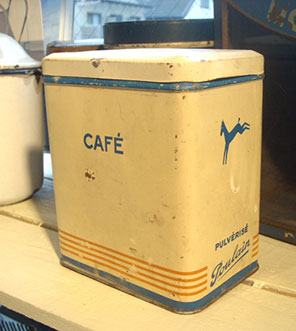 |
| The jumping foal trademark shown on the side of the canister above is a play on the chocolatier’s surname: Poulain = “foal” in French. |
The following images are from a set of collecting cards included in packages of Poulain chocolate and products by other vendors, likely from the beginning of the twentieth century.
Chocolat Poulain is a French brand of eating and cooking chocolate that was founded in 1848 by Victor-Auguste Poulain. According to Wikipedia (English; French), Poulain’s marketing acumen is arguably responsible for the wide distribution of chocolate that we take for granted today. A predecessor chocolatier, Menier, originally had a different niche for his product, selling it as a pharmaceutical. Poulain used a number of marketing devices that included the following.
- Collecting cards and postcards that covered everything from “Disclosures of Science” to the “Conquest of le Tonkin [Vietnam]” as portrayed by children to absurdist art
- Chansons de France (Songs of France; later Télé-Chansons de France), song books and phonograph records in several editions, including Rythmes et Chansons (1960)
- “Les Dossiers du Chocolat Poulain,” a series of educational briefs
- Stereoscopes featuring distinctive half-moon shaped lenses, accompanied by images of European historical destinations
- Photo albums, including Voyages & Chansons and Vacances et Chansons, containing blanks for collector stickers obtained in Poulain products, early 1970s
- Resined, plastic, and imitation chocolate keychains
- Sponges (!)
- Model motor vehicles emblazoned with Poulain emblems
- Enameled pins and magnets
- Several photo series, including “Knowledge of Chocolate”
- A cookbook produced in conjunction with the Grands Moulins [Mills] de Paris
- Placemats
- The Adventures of Tintin tie-in: “Chèques Tintin” from Poulain packages could be redeemed for model cars
- And let’s not forget the famous Poulain odalisque
Poulain was not the only chocolatier to issue collecting cards; see Patrick Marks’s Flickr photostream for examples from Van Houten, A. Driessen (including “hold to light” cards that contained watermarks), Grootes (including alphabet and animal series), Cadbury (including “sewing cards,” which you could stitch), Korff, and many more.
The three Poulain cards pictured here, from the set “Les Minéraux,” are printed via a lithography that gives them a soft-edged appearance. The pointillist shadings actually appear to be a halftone process. Each of the illustrations is framed by an Art Nouveau design. One, curiously, is altogether absent the Poulain brand.
Also included here is a single card from the same lithographer employed by Poulain, promoting superior quality chicory offered by C. Beriot, of Lille; and a card issued by Compagnie Coloniale, which, like Menier played up the supposed wellness attributes of chocolate (“véritable chocolat de santé”; “real health chocolate”).
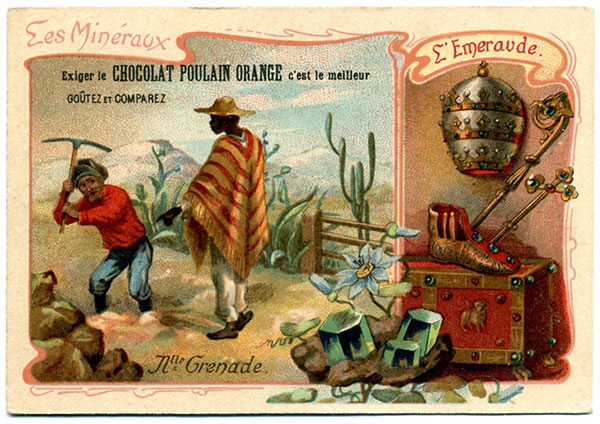 |
| Emerald, New Granada. The emerald itself is a combination of silica, alumina and a compound called beryllium oxide. Its usual forms are 6-sectioned prisms. The color of choice is green, which is due to chromium oxide but there are also several other colors. ¶Emerald is a gem of a pleasant appearance found in Muso (New Granada), associated with quartz. ¶Oriental emerald, a green variety of corundum, is formed of pure alumina. (Images from the collection of Bill Larson) |
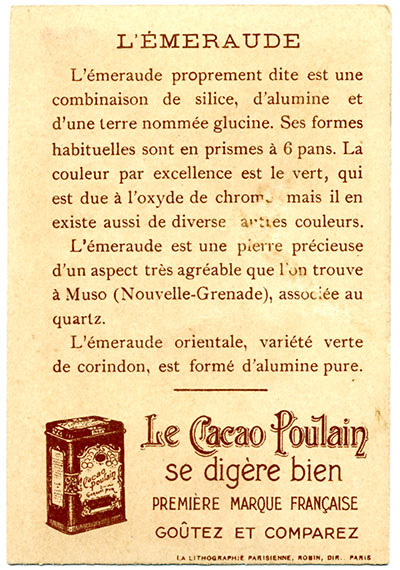 |
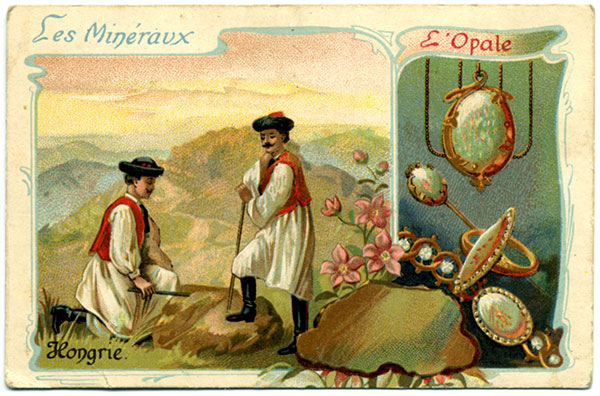 |
| Opal, Hungary. Opal is amorphous hydrated silica. This substance never crystallizes; it contains 2 to 13 % of water. ¶The noble opal is the most prized variety. Basically, generally milky, it has iridescent reflections and variations, which may change or disappear; this coloration is due to cracks and bubbles of air it contains. It is used in jewelry where it is known by the oriental opal name. The finest specimens come from Hungary. ¶Iron opal is another variety that is found in Mexico. (Images from the collection of Bill Larson) |
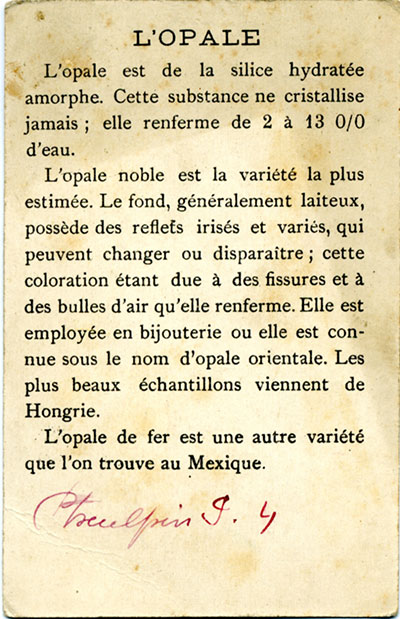 |
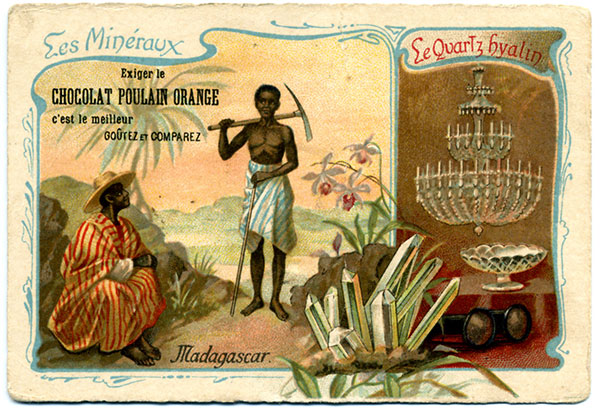 |
| Hyaline Quartz, Madagascar. Hyaline quartz or rock crystal quartz is in its highest state of purity. It is colorless, transparent and occurs in hexagonal prisms terminated by a 6-sided pyramid. ¶Quartz resembles fine crystal, but it is lighter and much harder. It is sometimes colored by foreign substances and thus rivals gemstones. ¶Hyaline quartz commonly occurs in the voids or veins of quartz of some crystalline rocks. The Alps have provided in quantity, but most white comes from Madagascar. ¶Items made from quartz are buttons, seals (stamps), cups, chandeliers. (Images from the collection of Bill Larson) |
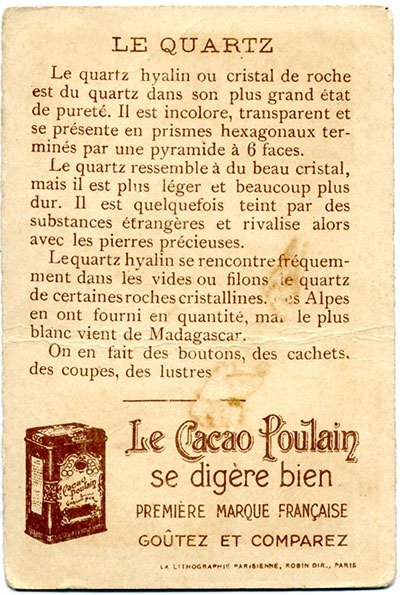 |
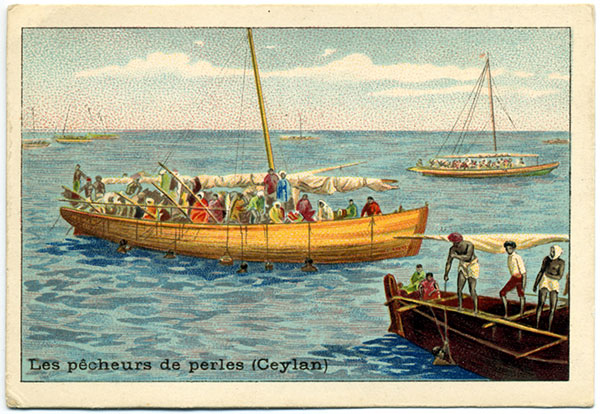 |
| Pearl Fishers (Ceylon). The pearl fisheries of Ceylon are the best regulated in the world. Fishing takes place only during the quiet north-east monsoon (February to April), from sunrise to sunset. Divers descend by a stone tied to a rope, with a loop to take their foot; arrived at the bottom, the diver fills the net he holds with oysters, then pulls on the rope of the net, the other end being held by a man in the boat. The latter man gives the rope a jerk that gives the diver enough momentum to help him up. For a few minutes, the diver breathes on the surface of the water and then descends again. (Images from the collection of Bill Larson) |
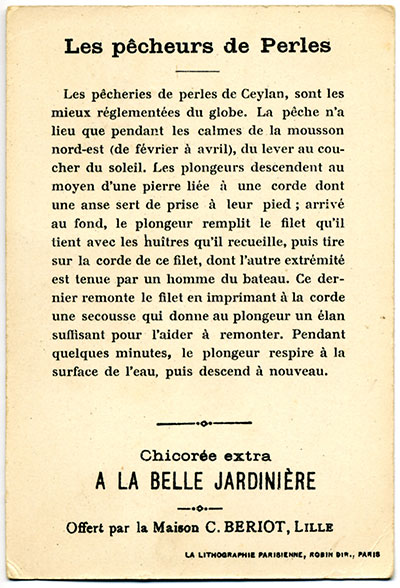 |
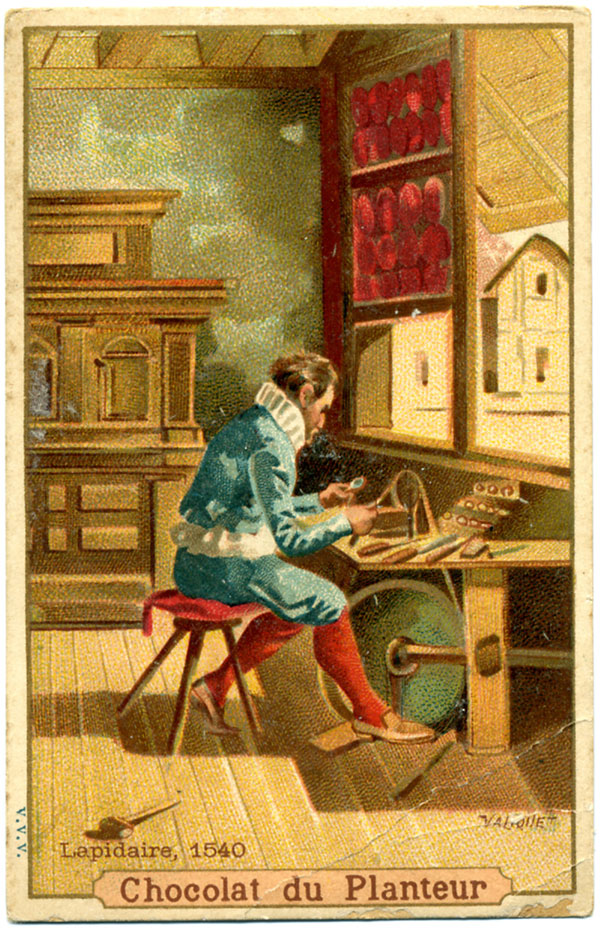 |
| Lapidary, 1540. This card appears to be from a series of at least 46 professions and businesses, mostly unrelated to gemstones. It contains no description of the lapidary on the reverse, only the following promotional text: RECOMMENDED PRODUCTS ¶CHOCOLAT du PLANTEUR ¶Real Health Chocolate, guaranteed pure Cocoa and Sugar ¶CHOCOLATE of the COLONIAL COMPANY ¶(High Quality) ¶TEA of the COLONIAL COMPANY ¶UNIQUE QUALITY (HIGH QUALITY) ¶Composed exclusively of the best kinds of BLACK TEAS of China in boxes of 75, 150 and 300 grams. (Images from the collection of Bill Larson) |
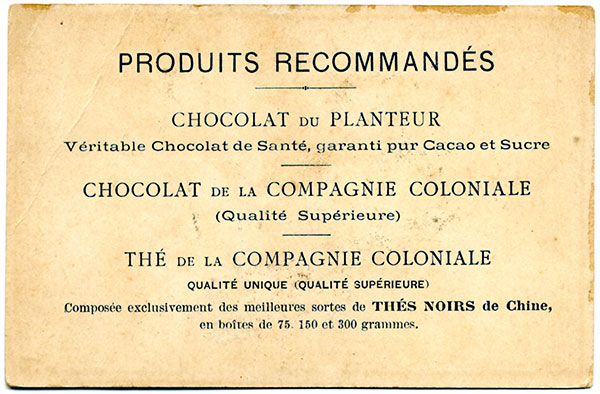 |
Note: Palagems.com selects much of its material in the interest of fostering a stimulating discourse on the topics of gems, gemology, and the gemstone industry. Therefore the opinions expressed here are not necessarily those held by the proprietors of Palagems.com. We welcome your feedback.